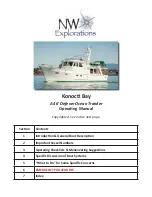
18
7027 • A2 07/11
DC e
leCTriCal
s
YsTem
s
eCTion
2
2 . Neutralize the acid in the electrolyte by pouring baking soda on the spill .
3 . Remove the neutralized electrolyte, using a disposable rag or paper towel .
4 . Replace damaged/leaking battery .
Batteries are relatively maintenance free; however, to increase the batteries effectiveness and life perform the following:
Keep the batteries fully charged at all times . Batteries that are kept fully or near fully charged last longer than batteries stored
•
with a partial charge . The charge level of the batteries can be monitored using the voltmeters on the helm instrument panel
(engine batteries) or tribulation panel (accessory batteries) .
Inspect the batteries at least once every 30 days for corrosion, loose wiring, dirt, etc .
•
WarNiNg
DISCONNECT THE bATTERIES bEFORE CLEANING.
•
Periodically clean the battery terminals and cable connections . Remove any accumulation of dirt on the top of the battery case .
Use a wire brush to clean the terminals . Coating the terminals with a terminal protecting product will help reduce corrosion that
can form in these areas .
• Make sure the battery cables are securely attached to the terminal posts . Tighten the terminal nuts snugly using a torque
wrench, to 20ft/lbs .
•
Remove the batteries from the yacht during periods of extended storage in freezing climate areas . Store the batteries in a cool
(above freezing temperature), dry area . All batteries lose some charge during storage, but the lower the temperature the less
charge is lost . Avoid storing the batteries in a humid place .
Check the battery charge level once every three months using a hydrometer or installed voltmeter . Charge the battery if the
•
specific gravity of the battery is less than 1 .225 or the voltage is less than 24 Volts . AVOID OVERCHARGING THE BATTER-
IES .
NOTE:
Batteries are maintenance free . Electrolyte CANNOT be checked .
o
perating
tHe
dC e
qUipment
Power to the DC components is controlled by circuit breakers and individual controls for each component .
Three DC circuit breaker panels are equipped on the yacht:
• DC Bus Distribution Panel (Engine Room)
• DC Distribution Panel (Salon)
• Bridge Breaker Panel (Bridge)
DC bUS DISTRIbUTION PANEL (EN-
GINE ROOM)
DC bUS DISTRIbUTION PANEL
(SALON AFT)
DC bREAKER PANEL (bRIDGE)
Summary of Contents for 720 FLY
Page 1: ...HIN CDR__________________ 2012 Version 1 Marquis 720 FL Y Owner s Guide...
Page 2: ......
Page 4: ......
Page 6: ...Table of Contents 7027 A2 07 11 Lower Helm Components...
Page 7: ...Preface 7027 A2 07 11 i Bridge Helm Controls...
Page 10: ...Preface iv 7027 A2 07 11 PAGE INTENTIONALLY LEFT BLANK...
Page 41: ...7027 A2 07 11 29 DC Electrical System Section 2...
Page 42: ...30 7027 A2 07 11 DC Electrical System Section 2 PAGE INTENTIONALLY LEFT BLANK...
Page 56: ...PAGE INTENTIONALLY LEFT BLANK 7027 A2 07 11 44 AC Electrical System Section 3...
Page 59: ...Air conditioning system Stateroom deck 7027 A2 07 11 47 Internal System Section 4...
Page 62: ...Internal water system 50 7027 A2 07 11 Internal System Section 4...
Page 86: ...74 7027 A2 07 11 Propulsion Section 5 PAGE INTENTIONALLY LEFT BLANK...
Page 120: ...108 7027 A2 07 11 Warranty and Parts Section 9 Thru Hull Fittings...
Page 121: ...7027 A2 07 11 109 Warranty and Parts Section 9 Thru Hull Fittings...
Page 122: ...110 7027 A2 07 11 Warranty and Parts Section 9 Bill of Materials...
Page 123: ...7027 A2 07 11 111 Warranty and Parts Section 9 Marquis Limited Warranty...
















































